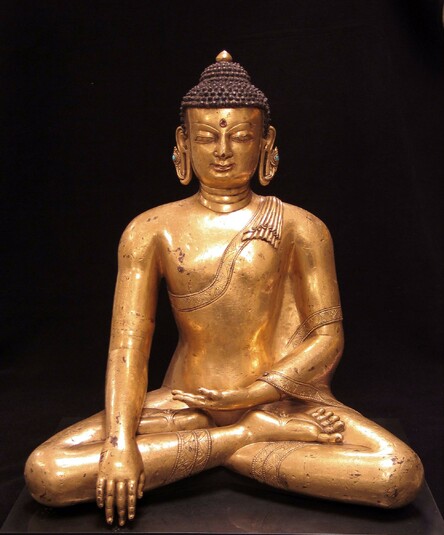
Item: Shakyamuni Buddha - Shakyamuni
| Origin Location | Nepal |
|---|---|
| Date Range | 1200 - 1299 |
| Lineages | Buddhist |
| Material | Copper |
| Collection | Rubin Museum of Art |
Classification: Person
Appearance: Buddha
Gender: Male
Shakyamuni Buddha (Tibetan: sha kya tu pa, sang gye. English: the Enlightened One, Sage of the Shakya Clan), the founder of Buddhism. (See Buddha Appearance Main Page and Shakyamuni Outline Page).
Sanskrit: Buddha Shakyamuni Tibetan: Sang gye sha kya tu pa
Tibetan: Sang gye sha kya tu pa
Formal in appearance, the Buddha gazes forward with partially closed eyes and the blue-black hair on the head is piled in a tuft on top with a single gold ornament adorning the crown. Between the eyebrows is a white dot (urna) and adorning the neck are three curved horizontal lines. The earlobes are long and pierced. With the right arm bare the right hand is extended across the knee in the earth touching gesture (mudra). The left performs the gesture (mudra) of meditation - palm upward in the lap. Across the left shoulder is a saffron coloured patchwork robe. A similar lower garment is tied at the waist with a cloth belt. The legs are folded in vajra posture.
"Born in the Shakya race through skillful means and compassion; destroying the army of Mara who was unable to be destroyed by others; with a body radiant like a mountain of gold. Homage to you, King of Shakya." (Sakya liturgical verse).
A Buddha is known for having thirty-two major and eighty minor distinguishing physical characteristics (marks) based on the Indian cultural description of a Universal Monarch (Chakravartin) - the highest and most developed male form. Only a few of these 112 marks are depicted in art such as the ushnisha on the top of the head, the urnakesha between the eyes, three curved horizontal lines on the neck, a Dharma Wheel impression on the palms of the hands and soles of the feet.
This particular sculpture of Shakyamuni Buddha has some characteristics that are different from the more standard Himalayan and Tibetan examples. What is immediately apparent and unique are the small earrings and jewels. They look more like ribbons with a jewel attached. These are unusual adornments for any Nirmanakaya appearance Buddha, however, here they are identified and commonly associated with the artistic style prevalent during the period of the Kasa Malla Kingdom of West Nepal. A second unusual characteristic is the appearance of musculature on the shoulders, arms and the buttocks (when the object is seen from the back). Early Buddhist writings describing the physical appearance of the Buddha described the form as soft and supple. Once again, the aesthetics of form and beauty at the time of the Kasa Malla Kingdom preferred a more athletic physique with clear muscle tone and more defined body lines and curves.
Vajra Posture: a Buddhist term referring to a seated position where the feet are placed sole up on the thigh of the opposite leg; right over left. In the West this posture is almost universally referred to as the lotus posture because that is the name used by the major Hindu traditions and in Hatha Yoga, subjects which are generally more familiar to Western audiences. The location of the Buddha's enlightenment in India, now called Bodhgaya, is called Vajrasana in Buddhist literature. The posture the Buddha sat in while reaching enlightenment is the vajra posture, and the highest meditation (samadhi) that is accomplished on reaching Buddhahood, in this vajra location and seated in vajra posture, is vajra samadhi.
Jeff Watt 3-2006
Exhibition: From the Land of the Gods: Art of the Kathmandu Valley
Publications
Definition: Himalayan 'Style' Art
Publication: Holy Days of the Tibetan Lunar Calendar
HAR: Jeff Watt - Profile
HAR: Introduction to Himalayan Art
Publication: Selection of Works - Sculpture (RMA)
Bibliography: Religious Context Publications
Thematic Sets
Subject: Hand Gestures (Buddha)
Sculpture: Three Topics Outline
Subject: Posture
Subject: Thirty-Two Major & Eighty Minor Marks
Shakyamuni Buddha: Sculpture (Without Base, Seated)
Subject: Images on HAR
Region: Himalayan Art (All)
Sculpture: Main Page (Three-dimensional Art)
Sculpture: Figurative Parts & Composition
Shakyamuni Buddha: Main Page
Buddhist Deity: Buddha Art History
Subject: Aphorisms (Chinese Language)
Chinese Language: 中文主页, Main Page
Collection of RMA: How or Why an Object was Acquired
Collection of Rubin Museum (Nepalese Sculpture Masterworks)
Collection of Rubin Museum of Art: Sculpture Main Page
Shakyamuni Buddha: Art History
Nepal: Khasa/Yatse Masterworks
Collection of Rubin Museum of Art: Nepal
Sculpture: Famous Works
Collection of RMA: Best of Collection (Sculpture)
Subject: Aphorisms for Himalayan Art & Iconography
Subject: Eyes in Himalayan Art
Shakyamuni Buddha: Iconography
Chinese: Introduction
Subject: Shakyamuni Buddha Number Sets
Shakyamuni Buddha: Sculpture Masterworks (Seated)
Subject: Masterworks (Buddha, 佛陀, སངས་རྒྱས།)
Collection of Rubin Museum of Art: Sculpture (Gallery 2)
Nepal: Khasa/Yatse Sculpture & Painting
Collection of RMA: Best of Collection 1
Collection of RMA: Selected Sculpture
Subject: Three Eyed Deities



